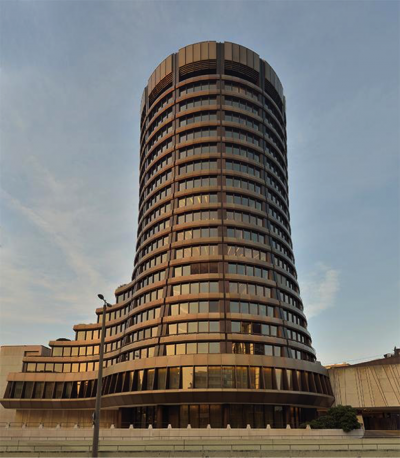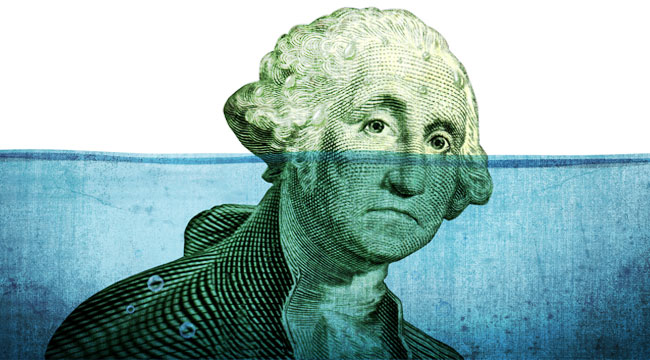The “Risky Trinity”
Observers are focused on tick-by-tick action in markets, and bounce from one Fed headline to the next without stopping to reflect on what’s really going on. Meanwhile, the long-term trends persist. These trends don’t go away just because everyone in the marketplace seems distracted all the time. The impact of these trends will not be denied.
The result of this short-term fixation is that a financial tsunami is about to overwhelm markets, while investors are asleep on the beach and don’t see the wall of water bearing down on them.
This is not speculation. These large trends and their deleterious impact on your wealth have been studied rigorously by official institutions with the best information and most qualified technical staff. Their reports are often lengthy and crammed with technical jargon and scores of pages of appendices, and technical footnotes. It’s not easy reading but it has its rewards.
Many official institutions either have obsolete models or political agendas that make some of their work unreliable. But there is one institution with extensive access to information and a good track record of sounding warnings in a timely way. That institution is the Bank for International Settlements (BIS).
BIS may be part of the global financial elite of which we are rightly distrustful. Yet, they have taken it upon themselves to diverge from the happy talk coming from central banks. Their recent research output has used more advanced models that incorporate some of the complexity theory and behavioral psychology that we use at Strategic Intelligence. BIS has been unafraid to call out their central bank peers on the dangers of low rates, asset bubbles, and systemic risk.
Let’s take a look at what the BIS has to say about instability in the global financial system and the threat it poses to your wealth and net worth.
The Bank for International Settlement (BIS) was established in 1930 by an inter-governmental agreement among the United States, UK, Germany, Belgium, Italy, France, Switzerland and Japan. The owners of the BIS are the central banks of the BIS members, with voting power skewed heavily in favor of a small number of the largest central banks.
BIS is headquartered in Basel, Switzerland, but it operates under exemptions and immunities from the laws of Switzerland and its member countries. In practice, this means BIS is a law unto itself accountable only to its central bank members.
The original purpose of BIS was to facilitate World War I reparations payments under the 1919 Treaty of Versailles. That purpose was made obsolete after the reparations process broke down in the early 1930s. But, the BIS quickly found a new mission as a meeting venue and operations center for transactions between central banks. If effect, the BIS is a central bank for central banks, offering clearing and settlement services.
BIS also specializes in the purchase, sale and leasing of gold bullion among central banks. The BIS balance sheet footnotes reveal that it conducts gold transactions for its member central banks but offers no details on the particular parties or amounts involved. In effect, BIS offers central banks an anonymous way to trade gold.

The modern-styled headquarters building of the Bank for International Settlements, (BIS), in Basel, Switzerland.
BIS operates outside the laws of any sovereign country. Heads of major central banks including the Fed, Bank of Japan, and ECB meet there monthly. No minutes of these secret meetings are made available to the public.
Despite this secrecy and BIS’s status at the top of the food chain of the global financial elite, BIS does maintain a website where it offers excellent financial data unavailable elsewhere, and independent research on the global monetary system. It also hosts seminars and symposia with leading central bankers and economists around the world.
Proceedings of those meetings are available at the BIS website. (For an excellent history of the secrets of BIS, including its back-channel dealings in Nazi gold during World War Two, I recommend Tower of Basel, by Adam LeBor).
Our interest in this issue is not the history or secrets of BIS, but rather what they are saying today about risk in the financial system. Because of its broad central bank membership, BIS researchers have better insight and better data from which to form risk assessments than any research department in the world. Their work deserves special attention.
The latest reports from BIS say that the world is on the brink of another financial catastrophe worse than 2008. This is not the fever dream of some fringe website. This is the considered opinion of the most plugged-in financial institution in the world.
These fears of systemic collapse were crystallized in a report by the General Manager of BIS, Jaime Caruana, delivered on June 26, 2016, just a few months ago. This report identified three major risks and three major threats arising from those risks. Caruana called these risks the “risky trinity.”
The three risks are excessive debt, lower productivity, and the absence of central bank policy options. The three threats to your wealth are systemic collapse, asset bubbles, and lost confidence in the ability of central banks to respond to crises. Today, we’ll look at the risk excessive debt poses.
Investors understand that excessive debt and leverage in the form of derivatives were a major cause of the Panic of 2008, along with banker fraud and government incompetence. Since then we’ve heard about the remedial steps regulators have been taking to make sure such a collapse does not happen again.
The U.S. Congress passed the Volcker Rule to limit banks’ derivatives exposure and risky trading. The Dodd-Frank legislation tightened up lending standards in mortgages requiring higher down payments and better loan underwriting.
Bank examiners have poured over bank books questioning any loans that were not fully collateralized or backed up by prime credits. With all of this regulation and scrutiny, one would assume that the pre-crisis mountain of debt has been whittled down to size.
Nothing could be further from the truth. In fact, debt and leverage in the system are much higher than they were in 2008, both in the U.S. and globally. The McKinsey Global Institute has provided a summary of increasing debt from 2007 through 2015. Their figures compare the periods 2000–07 and 2007–14, and break the debt into household, government, corporate, and financial (e.g. bank) sectors.
Their data reveals that total debt increased by $57 trillion since 2007. Not only did the total debt increase, but the debt-to-GDP ratio increased from 269% to 286%.
Debt-to-GDP is a critical measure of debt sustainability. If you are ever going to pay back or refinance your debt, you need economic growth to pay for it. When debt-to-GDP ratios go up, it means the debt is rising faster than the ability to pay. That’s a recipe for global bankruptcy.
Their data also reveals that government debt is growing faster than household, corporate, or financial debt. This reflects the fact that the government bailed out banks, corporations and consumers in the last panic. Total debt did not go down at all.
The bail-out was simply a case of substituting government debt for other forms of debt — total debt in the system still rose. For that matter, consumer, corporate and financial debt rose also, just not as fast as in the pre-2007 period. Government debt increases more than picked up the slack.
These figures from McKinsey do not reflect even greater debt accumulation since 2014. Trillions of dollars of additional debt have been incurred in the fracking industry and by emerging markets corporations. Some estimates show that total debt growth since 2007 has now exceeded $70 trillion.
In addition, there has been little inflation since 2007. That means that debt burden is real, not just the result of dollars being worth less.
On top of this balance sheet debt comes off-balance-sheet leverage in the form of derivatives, guarantees, and asset swaps of various kinds.
Not only is the debt higher, but it is also held in fewer hands, making the concentration of this debt much greater. The five largest banks in the United States now own a larger percentage of the total assets of the banking system than they did in 2008.
Everything that was too-big-to-fail in 2008 is bigger and riskier today. At the first sign of distress anywhere in the financial system, big banks will start to call in their loans from other big banks. The ability of financial institutions to rollover maturing liabilities will dry up. At that point, a financial panic bigger and more dangerous that 2008 will be underway.
In the last panic, central banks rode to the rescue by printing tens of trillions of dollars of new money and guaranteeing tens of trillions of dollars more in bank deposits, and money market funds, and by engaging in international currency swaps. But, central banks have now lost their flexibility to reliquify the system as we explain below.
The next financial panic will be much worse than the last one and will be essentially unstoppable except by the most draconian and confiscatory measures.
Regards,
Jim Rickards
for The Daily Reckoning
Ed. Note: The most entertaining and informative 15-minute read of your day. That describes the free daily email edition of The Daily Reckoning. It breaks down the complex worlds of finance, politics and culture to bring you cutting-edge analysis of the day’s most important events. In a way you’re sure to find entertaining… even risqué at times. Click here now to sign up for FREE.



Comments: